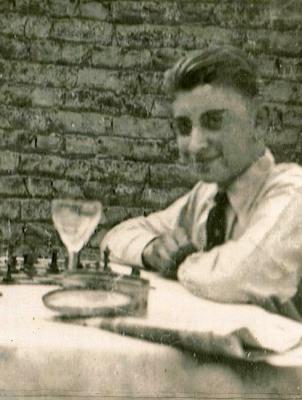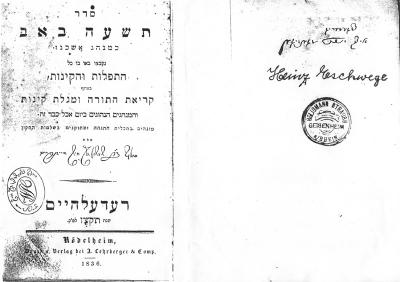This is the story of a prayer book and the souls it touched as it journeyed across the borders of war-ravaged Europe to new beginnings in Brazil, and then, decades later, finally brought comfort and closure to a bereaved brother in the United States.
The book is a sefer kinot, a prayer book containing liturgical prayers for recitation on Tisha B'Av – the Jewish day of fasting and mourning for the destroyed Temples. It was originally published in 1836 in Rodelsheim, Germany. While a Yiddish inscription names the original owner, by the 1930s the prayer book was owned by young Heinz Eschwege, who took it with him when he and his brother Alfred were forced to flee their hometown of Manheim, Germany as the Nazi occupation took hold.
Immediately following liberation, the sefer kinot found itself up for sale at a Brussels market, among other books abandoned by their Jewish owners. It became one of several Jewish titles presented to 10-year-old Samuel Rozenberg by his father. Rozenberg had been in hiding in the village of Quaregnon under the assumed identity of Paul Allain, and survived the war thanks to the kindness of Maurice and Lea Piérart (honored by Yad Vashem as Righteous Among the Nations in 1994). His father bought the books to bolster Samuel's knowledge of Jewish customs and rituals after spending such a long time with a non-Jewish family.
The books made a tremendous impact on Samuel; he cherished them and kept them with him as he began a new life in Rio de Janeiro, Brazil in 1950, where he studied medicine and became a respected member of the Jewish community. Year after year Rozenberg used the sefer kinot, read the name inscribed and wondered about the identity of its previous owner. "As I became older, the shadow of Heinz Eschwege followed me," Rozenberg explained. "Every Tisha B'Av eve I would read from the prayer book my father bought me, and ask myself: 'What happened to the owner of this book?'"
In 2005, after returning from Tisha B'Av services, Rozenberg decided to try to find out more about Heinz Eschwege. Searching on Yad Vashem's Central Database of Shoah Victims' Names, he found that a Page of Testimony had been submitted for Eschwege in 1990 by his brother, Alfred. Surprised and delighted, Rozenberg decided to contact Alfred, currently residing in New York. Through him, Rozenberg finally learned what had happened to the prayer book's owner.
After the war had ended, Alfred succeeded in finding out the details of his brother's tragic fate. Heinz was first taken to the Malines (Mechelen) concentration camp, situated in a former barracks by the river in the Belgian city. On 4 April 1944, he was sent on transport number 24 to Auschwitz. With the Allied forces closing in, Heinz died on 29 January 1945 in the Mittebau concentration camp during a death march.
"I had no choice but to send Alfred the prayer book, which I had kept in my possession for 60 years," explained Rozenberg. "I did so with pride and deep satisfaction, but also filled with sorrow to have finally discovered the sad fate of Heinz Eschwege."
Alfred Eschwege has recently submitted a photograph of his brother, which he had received from another Shoah survivor, to Yad Vashem. The photograph has been attached to the Page of Testimony, and completes Alfred's efforts to preserve the memory of Heinz Eschwege, whose life was cut short by Nazi brutality at such a young age.
When Alfred Eschwege received the book from Rozenberg, he was deeply moved. "I was at a loss for words," he recalled. "The book is the only remaining tangible object I have that belonged to my brother." In an emotionally charged email to Rozenberg, Eschwege wrote: "I cherish Heinz's prayer book above all the other possessions I own. Thank you again, from the bottom of my heart. It's not very often that you find people with a kindness like yours."








